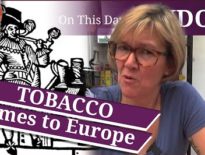On this day in Tudor history, 6th March 1536, King Henry VIII's Dissolution of the Monasteries began when the “Act for the Suppression (or Dissolution) of the Lesser Monasteries” was introduced into the Reformation Parliament.
The Dissolution of the Monasteries had a major impact on England and her people, but was of great benefit to the king, his nobles and the gentry. Find out what happened, why and its impact in this talk.
Also on this day in Tudor history, 6th March 1492, scholar and humanist Juan Luis Vives was born. He advised Catherine of Aragon on Princess Mary’s education. Find out all about what he advised in last year’s video:
Also on this day in history:
- 1547 - Thomas Wriothesley, 1st Earl of Southampton, lost the Great Seal of his Lord Chancellorship and was confined to his home at Ely Place for abusing his authority. He was found guilty of issuing a commission without the knowledge or permission of the other executors of Henry VIII's will, but it was probably more to do with his opposition to Edward Seymour, Duke of Somerset, becoming Lord Protector. He was later re-admitted to the Privy Council, a position he'd also lost at his fall.
- 1597 - Death of William Brooke, 10th Baron Cobham, courtier and diplomat, from an ague. He died at Blackfriars and was buried at St Mary Magdalene Church, Cobham. Brooke was the son of George Brooke, 9th Baron Cobham, and his wife, Anne (née Bray), an attendant horsewoman at Anne Boleyn's coronation. In Elizabeth I's reign, Cobham served as Lord Warden of the Cinque Ports, Constable of Dover Castle, Lord Lieutenant and Vice Admiral of Kent, and Privy Councillor.
Transcript:
On this day in Tudor history, 6th March 1536, the “Act for the Suppression (or Dissolution) of the Lesser Monasteries” was introduced into the Parliament known as the Reformation Parliament. This was the beginning of the Dissolution of the Monasteries.
The Reformation Parliament had first sat in October 1529 and is referred to as the Reformation Parliament because it was responsible for passing the legislation which led to the break with Rome and the English Reformation. As Clare Cherry and I wrote in our book George Boleyn: Tudor Poet, Courtier and Diplomat:
“The Reformation Parliament was established on the theory that England was governed by one supreme head, namely the King, and that all jurisdiction in the land, including that of spiritual matters, belonged to the King. It naturally followed that no foreign power could dictate English public policy – specifically, the Pope. It established that only law enacted by a monarch within a sovereign state was binding; hence, this sovereign power was supreme and gave the King and Parliament authority over church law.”
The Reformation Parliament been recalled in February 1536 and it met until it was dismissed on 14th April 1536.
For those of you interested in the Boleyns, George Boleyn attended this Parliament from February 1533 to its close in April 1536, and was actively involved in the Reformation until his downfall at the beginning of the following month.
The Act for the Suppression (or Dissolution) of the Lesser Monasteries affected monasteries with fewer than twelve members and those worth less than £200 per year. They were to be dissolved, their heads pensioned off and their members to become secularized or moved to larger monasteries “where they may be compelled to live religiously for reformation of their lives”.
This dissolution followed visitations ordered by Thomas Cromwell and authorised by King Henry VIII in 1535. By the 1520s, there was widespread indignation at how some abbots and monks were behaving, their vice, immorality, hypocrisy and wealth. Religious tracts had been written against them. In 1535 the king authorised his right-hand man, Thomas Cromwell, to carry out visitations to religious institutions and gather evidence on any irregularities and abuses. However, the concern about abuses was only one reason for the visitations and was probably only a pretext, it was more about King Henry VIII wanting to get his hands on the wealth of the monasteries. Some of the scandals and abuses uncovered were true, but others were completely made up to justify the closure of the monastery.
And dissolving the lesser monasteries wasn’t enough for the king. In 1539, the remaining monasteries were dissolved, with most of the land and profits going to the Crown, and then land being resold to nobles and gentry.
The monasteries weren’t just communities of religious people, they were the social welfare system of the day. They fed the poor, cared for the elderly and infirm, acted as hospitals, orphanages, schools and care homes, and provided accommodation for travellers and pilgrims. Their closure had an impact both on the English landscape and the English people. Awful.
I do love visiting the ruins of dissolved abbeys. Rievaulx Abbey and Whitby Abbey in North Yorkshire are two of my favourites – have you visited any?



I love the monastic remains, they are so evocative. The ruins rise majestic and dark against the sky. I can’t think how many I have visited, several are ruinous but a few the main Church and building remained. Whitby, Rievault, Sawley, Whalley, Butland, Boulton, Sweetheart, Fountains, Tewkesbury, Carmel Priory, Glastonbury, Hailes Abbey and beautiful small Medieval Church with unique paintings and so many, including local Norton Priory. I would love to go to Tetford to see where the early Howard family and Mowbray Dukes originally lay. My favourite was the King Arthur like Monastery of Tinten Abbey in Monmouth. It is really romantic and has connections to the Herberts. I just loved the location.
This was a terrible shameful act of wilful vandalism and sacrilegious destruction, a great loss.